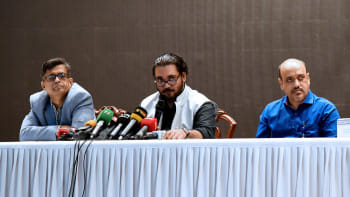Migrant Souls

Untold Stories of Migrants: Dreams & Realities is a book of immense contemporary relevance. The theme of the book—the experience of migration of Bangladeshi migrants in recent decades--has been treated sporadically in written literature for some time now. For example, in the 1980s, Bahrain Mukherjee wrote a collection of stories on migrants to Canada titled Darkness and another on the movement of South Asians to the United States in The Middleman and Other Stories; at around this time, Amitav Ghosh wrote novels like The Circle of Reason and Shadow Lines about translational movement of population as well. Somewhat later, Monica Ali fictionalized the lives of some Sylheti migrants in London in 2003 and Kiran Desai those of South Asian ones in New York in her 2006 Booker Prize winning novel The Inheritance of Loss.
However, the voices of Bangladeshi migrants working in low-skilled and unskilled professions in the Middle East and Southeast Asia have not been documented extensively and systematically till now. Viewed in this context, Untold Stories of Migrants: Dreams & Realities is a significant attempt to tell the stories of such migrants in documentary form. In this work the life stories of many male and female migrants have been recorded vividly and in some detail. We hear them recount the way they experienced migration and coped with the problems of settling down anew in a new world in some detail in the book.
Tasneem Siddiqui has authored Untold Stories of Migrants: Dreams & Realities skillfully with the help of a dedicated team of Canadian as well as Bangladeshi researchers. The book itself is a publication of RMMRU, an organization that has been contributing significantly through its pioneering research on different aspects of migration from Bangladesh in recent years. However, this book is more than a scholarly book and is compelling reading for us because of the authentic ring of the stories contained in it. Moreover, it can be read easily and the accounts of migrant lives reproduced in it can be appreciated by the general reader as well as scholars. Indeed, Untold Stories of Migrants: Dreams & Realities is designed for the reading of anyone who would like to relate to the lives of migrants, understand the reasons why they leave home for life overseas, and take note of the traumas experienced during migration and the disappointments of migrants as well as appreciate the positive sides of the migrant experience.
While the book will be valuable for anyone interested in the Bangladeshi experience of migration, it has to be said that the book has its limitations. For one thing, there is a kind of sameness to the accounts in that the stories reproduced are more or less of the same length and have the same kind of summary quality to them. It would have been preferable to have some long narratives of migrant lives alternate with the shorter accounts that make up the bulk of the book. Also, because of the summary form that dominates the telling of the narratives, the reader might feel jaded after a while and less and less interested in the later narratives. The work also could have benefited from a concluding chapter discussing the implications of the stories collected in it and coming up with recommendations for policymakers nationally and internationally.
One other criticism of the book is that it limits itself to labor migrants. It would have been more interesting to read the stories of all classes and from the different part of the world to which Bangladeshis have been migrating. It would be interesting to read not only the stories of labor migrants who send money home but also of some of the relatively more affluent migrants who remit money from Bangladesh to the country of destination they decide to become citizens of for reasons other than that of employment.
Nevertheless, Untold Stories of Migrants: Dreams & Realities is an important work for anyone interested in the lives of Bangladeshi migrants. The stories contained in the book ring true and are often moving. These are stories of dreams fulfilled and unfulfilled, of lives lived often in great difficulty, but also of lives that are transformed by the experience of migration positively in significant ways. It is a book well worth reading by anyone wanting a comprehensive perspective on the migrant experience of Bangladeshis in our time. This book is also available online at www.rmmru.org/newsite/publications/e-book/ and www.mfasia.org
The reviewer is Professor, Department of English,University of Dhaka.


 For all latest news, follow The Daily Star's Google News channel.
For all latest news, follow The Daily Star's Google News channel. 



Comments